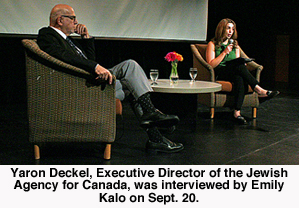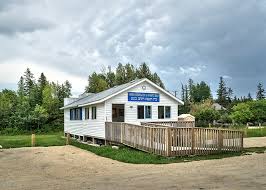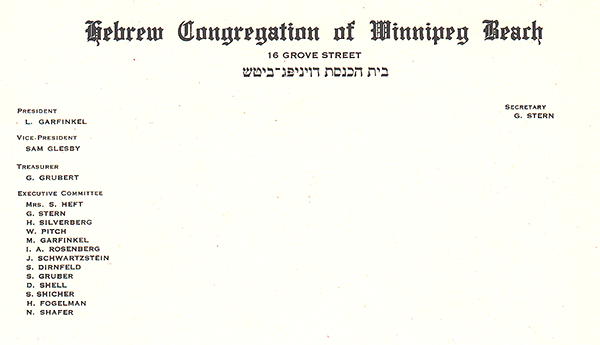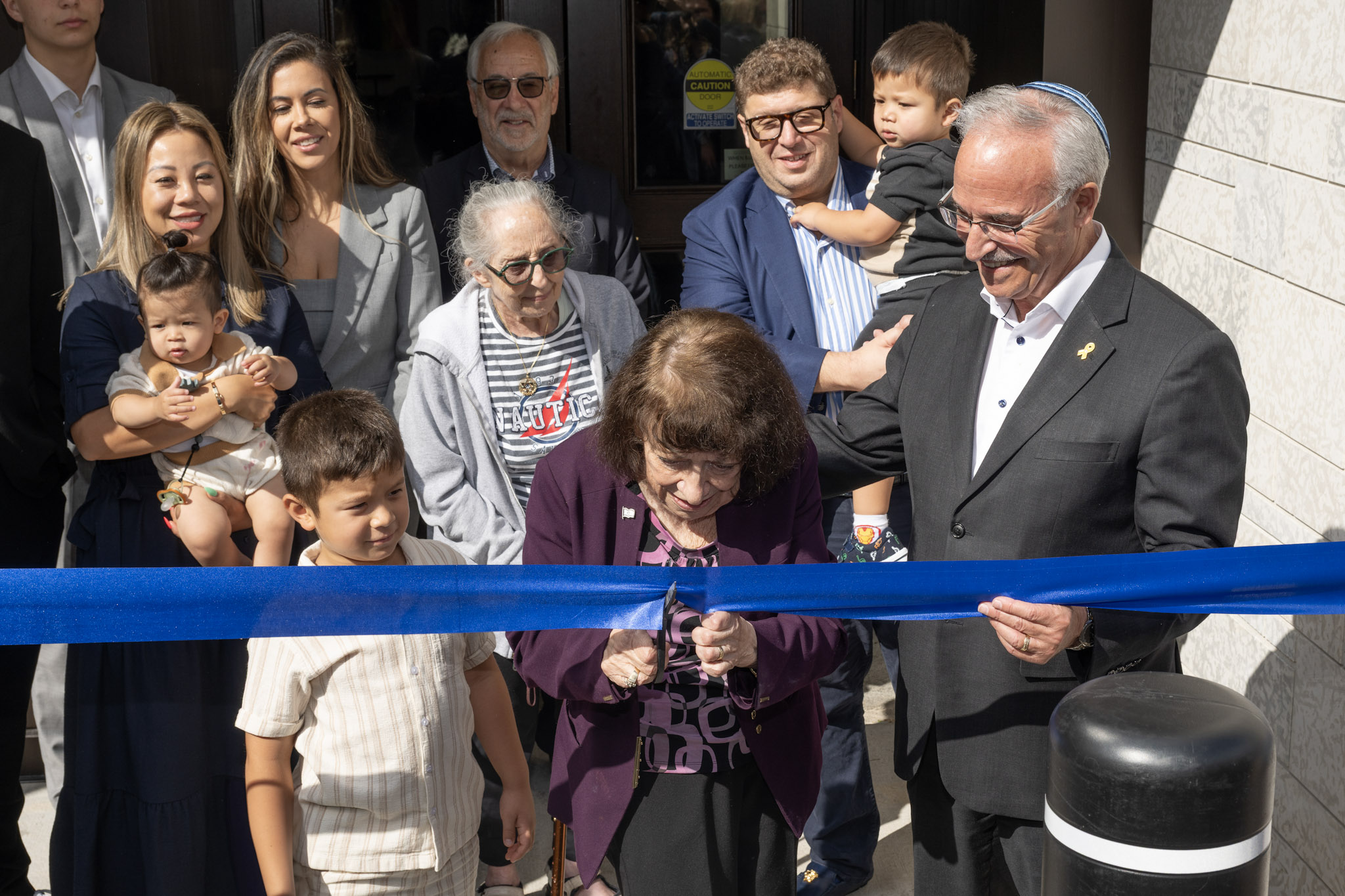Local News
CJA launches 2022-23 campaign with guest speaker from the Jewish Agency
 By BERNIE BELLAN The Combined Jewish Appeal of the Jewish Federation of Winnipeg launched its 2022-23 campaign before a small audience at the Berney Theatre on Tuesday evening, September 20. Welcoming remarks were given by Federation president Gustavo Zentner. Following his remarks, Zentner crossed the stage of the Berney Theatre where he introduced Ukrainian-born (and former resident of Israel) artist Eugene Kabrun. Together the two men unveiled a painting depicting the suffering ongoing in Ukraine and which will be on display at the campus.
By BERNIE BELLAN The Combined Jewish Appeal of the Jewish Federation of Winnipeg launched its 2022-23 campaign before a small audience at the Berney Theatre on Tuesday evening, September 20. Welcoming remarks were given by Federation president Gustavo Zentner. Following his remarks, Zentner crossed the stage of the Berney Theatre where he introduced Ukrainian-born (and former resident of Israel) artist Eugene Kabrun. Together the two men unveiled a painting depicting the suffering ongoing in Ukraine and which will be on display at the campus.
Following the unveiling of the painting, Zentner introduced the special guest for the evening, Jewish Agency executive director for Canada Yaron Deckel.
Deckel was accompanied to the stage by Emily Kalo, a fourth-year science student at the University of Manitoba (also a Gray Academy grad). Emily co-founded Students Supporting Israel at the University of Manitoba and is the StandWithUs Israel Advocate of The Year, 2018. She is currently a member of the Public Affairs and Advocacy Committee at the Jewish Federation of Winnipeg and serves as the Vice President of Advocacy at the University of Manitoba Students’ Union.
For the next hour Emily asked Yaron Deckel a series of relatively short scripted questions, ranging from what the Jewish Agency has done to help Ukrainian refugees, to asking about security provisions the Agency has helped Jewish organizations institute in response to heightened anti-Semitic attacks throughout the world. Emily also asked Deckel about how awareness of Israel can be increased among Jewish students on campuses.
Deckel gave lengthy answers to the questions posed to him, but what he didn’t do is explain to the audience just what the Jewish Agency is.
So, in an effort to better understand what the Jewish Agency is, here is a short primer, taken from Wikipedia. (Wikipedia admits on its website that much of its article on the Jewish Agency reads like an advertisement for the Jewish Agency.):
“The Jewish Agency for Israel (in Hebrew: HaSochnut HaYehudit L’Eretz Yisra’el) formerly known as The Jewish Agency for Palestine, is the largest Jewish non-profit organization in the world. It was established in 1929 as the operative branch of the World Zionist Organization (WZO). The stated mission of the Agency is to ‘ensure that every Jewish person feels an unbreakable bond to one another and to Israel no matter where they live in the world, so that they can continue to play their critical role in our ongoing Jewish story.’
“It is best-known as the primary organization fostering the immigration of Jews in diaspora to the Land of Israel (known as aliyah) and overseeing their integration with the State of Israel. Since 1948, the Jewish Agency has brought 3 million immigrants to Israel, and offers them transitional housing in ‘absorption centres’ throughout the country.
“By law, the Jewish Agency is a parastatal organization, but does not receive core funding from the Israeli government. The Jewish Agency is funded by the Jewish Federations of North America (JFNA), Keren Hayesod, major Jewish communities and federations, and foundations and donors from Israel and around the world.
“In July 2022, during the Russian invasion of Ukraine, the Russian Ministry of Justice took steps to stop the Jewish Agency For Israel from operating in Russia, claiming that the agency had broken Russian law regarding collecting, storing and transfering data. After the invasion started, there had been a sharp increase in emigration from Russia to Israel…
“Its operating budget for 2019 was US$379,807,000…
“As of 2019, the Jewish Agency sponsors dozens of programs that connect Jews to Israel and to each other. The Agency organizes the programs into four different categories: 1. Connecting young Jews to Israel and their Jewish identity (Jewish and Zionist education in the Jewish diaspora), 2. Connecting young Israelis to the Jewish people and their Jewish identity, 3. Aliyah and absorption, 4. Supporting vulnerable populations in Israel.”
While Deckel said all the right things about trying to engage young Jews in supporting Israel, as in “It’s time for us to invest in young people to try to make a difference, otherwise young people will be even less interested in Jewish identity,” that would hardly constitute startling news.
For anyone following world events these days though the Jewish Agency has been most prominently featured in the news of late as a result of Russia’s Ministry of Justice having filed a motion in court to liquidate operations of the Jewish Agency in Russia. While it is not clear what prompted that move, it did follow Israeli Prime Minister Yair Lapid’s criticism of Russia’s invasion of Ukraine. Deckel did not touch upon the purported attempt to force the Jewish Agency out of Russia.
Deckel did note in his remarks that 17,000 Russian Jews have emigrated to Israel since Putin’s baseless invasion began on February 24 (along with 40,000 Ukrainian Jews). Now that Putin has called for the mobilization of a further 300,000 reserve soldiers the number of Russian Jews attempting to leave that country can be expected to grow exponentially. The role of the Jewish Agency in helping Russian Jews to leave that country is bound to take on an even larger importance in the coming days.
Local News
Thank you to the community from the Chesed Shel Emes

We’re delighted to share a major milestone in our Capital Campaign, “Building on our Tradition.” Launched in November 2018, this campaign aimed to replace our outdated facility with a modern space tailored to our unique needs. Our new building is designed with ritual at its core, featuring ample preparation space, Shomer space, and storage, creating a warm and welcoming environment for our community during times of need.
We’re grateful to the nearly 1,000 generous donors who contributed over $4 million towards our new facility. A $750,000 mortgage will be retired in November 2025, completing this monumental project in just seven years.
We’re also thrilled to announce that our Chesed Shel Emes Endowment Fund has grown tenfold, from $15,000 to $150,000, thanks to you, the Jewish Foundation of Manitoba’s FundMatch program, and Million Dollar Match initiative in 2024. Our fund helps ensure that everyone can have a dignified Jewish funeral regardless of financial need.
As we look to the future, our goal remains to ensure the Chevra Kadisha continues to serve our community for generations to come. Our focus now shifts to replenishing our savings account and growing our JFM Endowment fund.
We’re deeply grateful for your support over the past several years.
It’s our privilege to serve our community with care and compassion.
With sincere appreciation,
Campaign cabinet: Hillel Kravetsky, Gerry Pritchard, Stuart Pudavick,
Jack Solomon, and Rena Boroditsky
Murray S. Greenfield, President
Local News
Winnipeg Beach Synagogue about to celebrate 75th anniversary

By BERNIE BELLAN (July 13) In 1950 a group of cottage owners at Winnipeg Beach took it upon themselves to relocate a one-room schoolhouse that was in the Beausejour area to Winnipeg Beach where it became the beach synagogue at the corner of Hazel and Grove.
There it stayed until 1998 when it was moved to its current location at Camp Massad.
On August 2nd members of the synagogue will be holding a 75th anniversary celebration.

As part of the celebration anyone who is a descendant or relative of any of the original members of the first executive committee (as seen in the photo here) is invited to attend the synagogue that morning.
If you are a relative please contact Abe Borzykowski at wpgbeachshule@shaw.ca or aborzykowski@shaw.ca to let Abe know you might be attending or for more information about the 75th anniversary celebration.
We will soon be publishing a story about the history of the beach synagogue, which is something I’ve been writing about for over 25 years.
Local News
Vickar Family cuts ribbon on new Tova Vickar and Family Childcare Centre

By MYRON LOVE In the words of Larry Vickar, the Shaarey Zedek’s successful Dor V’ Dor Campaign “is not only a renewal of the synagogue but truly a renewal movement of Jewish life in our community.”An integral part of that renewal movement was the creation of a daycare centre within the expanded synagogue. On Monday, June 23, Larry and Tova Vickar cut the ribbon, thereby officially opening the Tova Vickar and Family Childcare Centre in the presence of 100 of their family members, friends and other supporters of the project.
The short program preceding the morning ribbon-cutting began with a continental breakfast followed by a welcome by both Fanny Levy, Shaarey Zedek’s Board President, and Executive Director Dr. Rena Secter Elbaze. In Elbaze’s remarks, she noted that Larry and Tova wanted their family (including son Stephen and family, who flew in from Florida) and friends at the event to celebrate the opening of the Tova Vickar and Family Childcare Centre, “not because of the accolades, but because, as Larry put it, he hopes that their investment in the congregation will inspire others to do the same.”
“When Larry and I spoke about what this gift meant to him and the message he wanted people to take away,” she continued, “I couldn’t help but connect it to the teachings of Reb Zalman Schachter-Shalomi whose book – Age-ing to Sage-ing – changes the whole way we look at the concept of ageing and basing it on our ancestral teachings.”
She explained that his concept of “Sage-ing” is based on three key ideas – Discover your meaning and purpose; accept our mortality and think about the legacy you want to leave.
“Larry spoke about these exact concepts when we met,” she said.
Elbaze also noted the presence of Shaarey Zedek’s newly-arrived senior Rabbi Carnie Rose, former Rabbi Alan Green, and area MLAs Mike Moroz and Carla Compton.
Larry Vickar expressed his great appreciation for all those in attendance. “Tova and I are deeply moved to stand here with you today for this important milestone in our community”, he said. “We are grateful to be surrounded by all of you, the people we care about, our family and friends… you who have touched our lives and played some part in our journey.”
